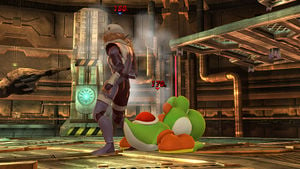Rage
Rage is a mechanic introduced in Super Smash Bros. 4. It was originally discovered by the Japanese community at the launch of Super Smash Bros. for Nintendo 3DS in September 14, 2014, and was first referred to as the "Hot Hot Effect". Ayuha and Chibo worked together to make a tutorial video on it and bring the information to the western scene, where Chibo then named it the "Rage Effect". Rage functions similarly to Aura: a character's attacks will deal increased knockback as they accumulate more damage, though it does not affect an attack's damage output. Rage begins to take effect past 35%, and caps at 150%. At maximum rage, an attack's knockback will be 15% higher than normal. Rage is visually denoted by characters flashing red and emitting steam when they reach 100%,[1] which become more visually intense as the characters' damage increases until 150%. However, rage starts applying long before the visual indicators appear.
Rage's multiplier is 1 + [(p - 35)/115 * 0.15], where p is the damage of the attacker (but no less than 35% and no greater than 150%)[2]. Thus, the minimum possible multiplier is 1× (no rage), whereas the maximum possible multiplier is 1.15× (all knockback is increased by 15%). This multiplier is applied to the end of the knockback formula (as the variable r), alongside other conditional ratios, such as the crouching penalty (0.85×), smash attack charge interruption bonus (1.2×), and grounded meteor smash penalty (0.8×). The first two multipliers are mutually exclusive to each other, as one cannot be crouching and charging a smash attack (even down smash) at the same time. This multiplier can also be directly applied to the base knockback and knockback scaling values of moves, resulting in the same effective knockback when calculated. Like stale-move negation, rage is not present in single player modes, such as Training, though its visual effects are still present. As such, its effects can only be tested in Versus Mode.
The obvious application of rage is that it allows players at higher damages to score KOs earlier than they would be able to otherwise, which can help aid a losing player staging a comeback. However, rage is not necessarily a comeback-friendly mechanic. It can be used by players with leads to potentially survive for longer, as the player with a lower KO/stock count and damage cannot use their finishers as effectively. Furthermore, the increased knockback from rage can potentially prevent combos from working sooner than they normally would, especially in combos that involve set-ups from throws with high base knockback, thus preventing highly damaged players to increase the damage on a less damaged player. Rage can potentially assist in combos that rely on stage-specific combos that rely on forcing opponents onto specific platforms, but these combos, even without rage, can be more difficult to perform than standard combos.
Generally, heavyweights benefit the most from rage, as their greater endurance allows them to both experience rage longer and to a greater degree. Furthermore, most heavyweights are less reliant on combos compared to other characters, allowing for the greater use of increased knockback with little concern of it preventing vital combos. Conversely, characters that can rack up damage quickly without rage can lose out on several combos they can potentially perform when they start building rage, especially those that rely on grab set-ups, such as R.O.B.. Lightweights also do not strongly benefit from rage, as their lower endurance can shrink the window for which they can take advantage of rage.
